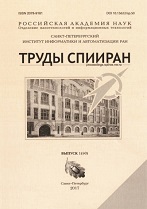|
|
Trudy SPIIRAN, 2009, Issue 10, Pages 121–130
(Mi trspy38)
|
 |
|
 |
Main contemporary models of software design based on FLOSS
A. I. Grigorieva, M. Yu. Kolodin
St. Petersburg Institute for Informatics and Automation of RAS
Abstract:
Software design based on Free and Open-Source Software (FLOSS) is highly required contemporary theme. On the first side, the amount of instrumental and organizational software is rather wide and is available on all software-hardware platforms, on the other side there are significant juridical and methodological difficulties and uncertainties in practical application of such software in Russia.
In these conditions it is necessary to study all the existing variety of solutions on all the main directions of software design and its support, to compare principal software and organizational means, to define which juridical norms are to be used nowadays.
On the level of operating systems (OS) we recommend to use Linux family, for server applications also FreeBSD is good; exactly these systems are better organized, protected and technologically supported. Free and not-paid-for systems like Sun Solaris have restricted applicability in our country, though they have many useful features. MS Windows systems are usually rather expensive, have many hidden functionality and closed code, are more unpredictable technologically; their application is possible for closed, large transnational corporations that have their own requirements for software, management procedures etc.
At the level of instrumental software we recommend open compilers like GNU, MinGW, as well as FLOSS versions of interpreted languages like Python (mainly), Perl, Tcl (less), versions control systems etc.
At the level of organizational means for collaborates and their collectives and for software design support we should note open office packages, as well as free network office and groupware organizing programs like Google (that have their open API).
Legally licenses like GNY, BSD Creative Commons and like do not contradict to the existing Russian laws; but in order to apply them correctly one should be very attentive in acquiring, registration and maintenance of such software. The organization should elaborate a set of exactly specified instructions for its associates and maintain the process of accounting for all the software used on everyday basis for all working places.
Generally application of closed and commercial, from one side, and of free software, from the other side, will be done in parallel; and it is normal, because it gives better selection possibilities for the users. Nevertheless, for most common cases we recommend to use FLOSS.
Keywords:
software design, technologies, maintenance, free software, efficiency.
Received: 14.12.2009
Citation:
A. I. Grigorieva, M. Yu. Kolodin, “Main contemporary models of software design based on FLOSS”, Tr. SPIIRAN, 10 (2009), 121–130
Linking options:
https://www.mathnet.ru/eng/trspy38 https://www.mathnet.ru/eng/trspy/v10/p121
|

| Statistics & downloads: |
| Abstract page: | 174 | | Full-text PDF : | 87 | | References: | 1 | | First page: | 1 |
|




 Contact us:
Contact us: Terms of Use
Terms of Use
 Registration to the website
Registration to the website Logotypes
Logotypes








 Citation in format
Citation in format 